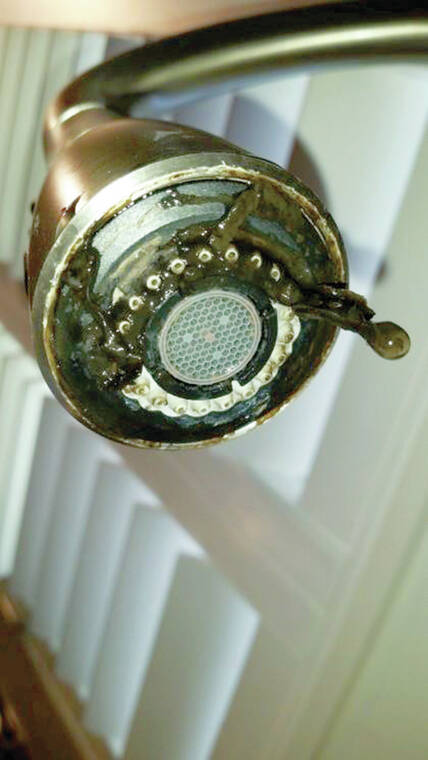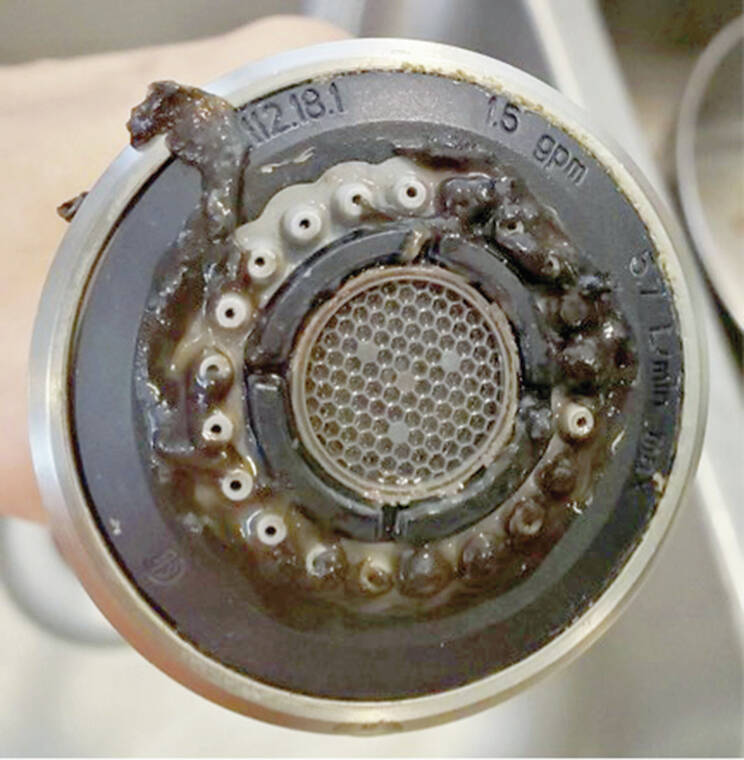Hanama‘ulu homeowners’ black-slime problem persists

Courtesy / Linda Sprengeler / Special to The Garden Island
A kitchen faucet coated in black biofilm is observed in residences throughout a Hanama‘ulu housing development.

Linda Sprengeler / Special to The Garden Island
The so-called “black slime” returned after a chlorination treatment performed by the homebuilder.
HANAMA‘ULU — Homeowners in a local housing development continue to fight chronic “black slime” biofilm and health issues they claim are caused by contaminated plumbing installed by the builder, nearly three years after some households first noticed the problem.
HANAMA‘ULU — Homeowners in a local housing development continue to fight chronic “black slime” biofilm and health issues they claim are caused by contaminated plumbing installed by the builder, nearly three years after some households first noticed the problem.
Now, weeks after some affected homeowners approached the media, others in the Ho‘oluana at Kohea Lea development are beginning to meet one another, exchange information and seek the resources needed to enter group arbitration with developer D.R. Horton, the largest homebuilder in the country.
“It was nice to meet the rest and just develop a rapport,” Christie Volkmer said in a recent interview, held at her dining table with husband Marc.
The Volkmers moved into their brand-new house — their first on Kaua‘i, after living in an apartment — in May 2018. They found “blobs of slime” dripping from multiple faucets in November 2020, after a three-month absence from the home.
“It had time to brew in there, I guess,” Marc Volkmer said.
The Volkmers reported their discovery to D.R. Horton.
What followed, they say, has been a months-long struggle to obtain a permanent remedy from the homebuilder, which denies responsibility.
In the meantime, the Volkmer family and their pet dog have displayed symptoms — including recurrent rashes and excessive sneezing — they believe stem from the black slime that accumulates on their faucets, showerheads and toilets despite routine deep-cleaning.
The Volkmers now drink bottled water and have installed a reverse-osmosis filter on their kitchen tap.
Marc Volkmer said he’s grateful his family hasn’t experienced other, more-serious conditions reported by neighbors.
“Other people, the health things that they have, I’m glad we’re not there,” he said. “But it’s ever-present … we have an abundance of it (water) and we don’t want to use it.”
Seventy-eight homes
Christie and Marc Volkmer are two of several Ho‘oluana residents who approached The Garden Island with similar stories. All 10 represent a fraction of the 78 total households reportedly contaminated with black slime.
Retired couple Linda Sprengeler and Tim Harris are responsible for determining the extent of the water contamination. Many neighbors met them when they conducted a door-to-door water-contamination survey of all 151 homes in the Ho‘oluana neighborhood.
“For a year and a half, I was constantly in the doctor’s office … the ear doctor cultured my ear and found Pseudomonas aeruginosa (bacteria),” Sprengeler told The Garden Island. “I then turned around, tested my shower water, and found high levels of Pseudomonas aeruginosa.”
Ultimately, Sprengeler and Harris repeatedly performed a battery of water tests throughout their home. They even removed and swabbed cross-sections of their interior pipes, and sent the collected specimens to a laboratory.
The tests’ results are conclusive, the couple said.
“The real key takeaway is the outside, street-side hose bibb: always good. Inside: always bad,” Sprengeler said.
Sprengeler’s ailments cleared up after Harris installed a portable shower connected to the street-side hose bib while the couple poured nearly $80,000 into a new copper-plumbing system.
“Ever since then, I have not had one single chronic eye infection, ear infection, skin infection, lung infection or throat infection, and I had all of those,” Sprengeler said.
Sprengeler has dedicated 60 hours per week to water-contamination issues for the past two years. She has read reams of peer-reviewed research papers and initiated correspondences with the microbiologists who authored them. She has contacted county, state and federal government agencies, and she has slowly completed the first two dispute-resolution steps required by D.R. Horton’s home-purchase contract.
“When my attorney (a former Hawai‘i Supreme Court judge) looked at their contract, he said, ‘Oh my God — this is the most-arduous dispute-resolution process I’ve ever seen in my life,’” Sprengeler recalled. “It’s designed specifically to exhaust people of their savings so they have to quit, or just break them emotionally.”
Sprengeler and Harris say they have spent more than $180,000 in their efforts to rectify their contaminated-water situation and receive reimbursement from D.R. Horton. Their life savings are depleted, and they cannot afford to continue the dispute-resolution process, the next step of which is group arbitration.
Sprengeler and Harris are now attempting to build a grassroots fundraising campaign to hire the attorneys and experts needed in arbitration, which they hope would result in the replacement of all affected homes’ pumbing systems. They’ve created “Ho‘oluana Friends” GoFundMe, Facebook, Twitter and email accounts to accomplish their goal.
The couple believes the arbitration process will take six months and cost an estimated $200,000.
“They know that people can’t fight back because they don’t have the financial resources, or they drag it out so long that people just give up,” Sprengeler said of D.R. Horton. “Now, most people would have given up. I don’t give up. It’s not in my vocabulary.”
No more baths
Lani Saiki and Matt Woods moved into their home in February 2019. Pink slime presented itself two months later, and was later followed by the black variety. Woods’ sensitive skin broke out in bumps and growths, some of which were removed by a doctor, who diagnosed the bumps as folliculitis caused by bacteria.
The couple’s son began exhibiting sores which lessened when showers were substituted for baths.
The Volkmers described an identical scenario regarding their young daughter.
Woods also reported everyday cuts and scrapes took an abnormally long time to heal until he began swabbing them with alcohol rather than washing them with tap water. Two neighbors, both of whom are medical professionals, told similar stories.
“I had appendicitis … and my wounds never healed,” Dr. Brigitte Carreau, a pediatrician at Wilcox Medical Center, said.
Only when Carreau’s plumbing was chlorinated by D.R. Horton — a treatment the homebuilder performed at 24 contaminated homes — did her wounds heal. But Carreau says the disinfection, which ultimately failed when the slime returned some months later, came too late.
“Now I have to have a certain surgery because I have a hernia because the thing didn’t heal,” Carreau said.
The other medical professional, a nurse who spoke on condition of anonymity, said her C-section scars have become red and inflamed. She is one of two women to report an aggressive yeast infection as well.
“It’s not a situation where we’re all hallucinating the same health problems,” the nurse said, noting her dog, like the Volkmers’, exhibited allergies when living within the Ho‘oluana development.
The nurse’s dog has since been re-homed with a family friend in Kalaheo.
Residents were unanimous in describing D.R. Horton as unresponsive and, at best, ineffectual: all who received D.R. Horton’s chlorine treatment say the black slime has since returned.
“We just need it resolved,” Saiki said. “We bought this home. It’s a brand-new home. We invested a lot of money into this, and we should have clean water coming out of our faucets.”
Responses
Mayor Derek Kawakami issued an open letter to Ho‘oluana residents in early October, announcing the state Department of Health Safe Drinking Water Branch conducted an investigation that found the area’s municipal water quality meets or exceeds all state and federal drinking-water standards.
The open letter included an attached communication from DOH Safe Drinking Water Branch Engineering Section Supervisor Michael Miyahira, who delivered his pronouncement in no uncertain terms.
“(I) found what I had expected all along — nothing. Absolutely nothing,” Miyahira’s letter reads.
The federal Environmental Protection Agency also understands the county Department of Water to be in compliance with the federal Safe Drinking Water Act, according to correspondence provided to The Garden Island by Sprengeler.
A spokesperson for EPA Region 9, which includes Hawai‘i, did not reply to The Garden Island’s requests for comment.
D.R. Horton’s Hawai‘i personnel responded with a written statement: “We have been working diligently to address the matter since it was brought to our attention. We appreciate our homeowners’ cooperation and patience during this process.”
The homebuilder claims its own experts’ testing has determined the biofilm lining Ho‘oluana plumbing systems is due to low levels of residual chlorine in the water supplied by county Department of Water.
But the EPA, in an email to Sprengeler, asserts the municipal water contains the minimum required chlorine residual concentrations at the point of delivery into the subdivision.
No other, similar complaints of black slime have been reported elsewhere on Kaua‘i or in the state, Miyahira told The Garden Island.
D.R. Horton did not address the slime’s apparent containment to its Ho‘oluana development.
Kaua‘i County has been in direct contact with the developer. A spokesperson said the county will continue to monitor the water-contamination issue until it is resolved.
County Councilmember Felicia Cowden has visited the Ho‘oluana neighborhood on two occasions.
Twenty-three residents, 21 of whom exhibited signs of illness or infection, met Cowden at the second community-outreach session, scheduled two days in advance.
“This was extraordinary, to come to a meeting like this, to have that much turnout that quickly,” Cowden recalled to The Garden Island.
The Volkmers, like Saiki, Woods, Sprengeler and others, just want D.R. Horton to employ a permanent solution to the problem.
“We’ve been so accommodating,” Christie Volkmer said. “…But they’re washing their hands of us, and I welcome them to come wash their hands in our faucets.”
•••
Scott Yunker, reporter, can be reached at 245-0437 or syunker@thegardenisland.com.


Attorneys will be coming to you to take the case on a contingency basis with no up front costs and they will also advance your expert costs so no out of pocket costs for you all. You pay when you settle or win at trial. Don’t sweat it. Interview multiple law firms and pick one with a good track record of winning construction defect cases.
Did you try putting a mask over the showerhead? Derek can show you how to make one from a t-shirt. Sounds like the same team investigating the water problem is the same team in charge of the island’s Covid policy.
All kidding aside, somebody fix this.
Are these houses plumbed with plastic pipe?
So much for affordable housing. I guess you get what you pay for.
Of course Kawakami backs the big money developers. Well you get what you elected !! The slime is probably from all the plastic in the ground left from the days of the sugar plantations water systems that they plowed under every year. Plowed under all the old tubing every year and would just lay more on the ground each season. Very destructive way to farm. Just go into any old sugar plantation and dig up the ground. Full of old deteriorated plastic.